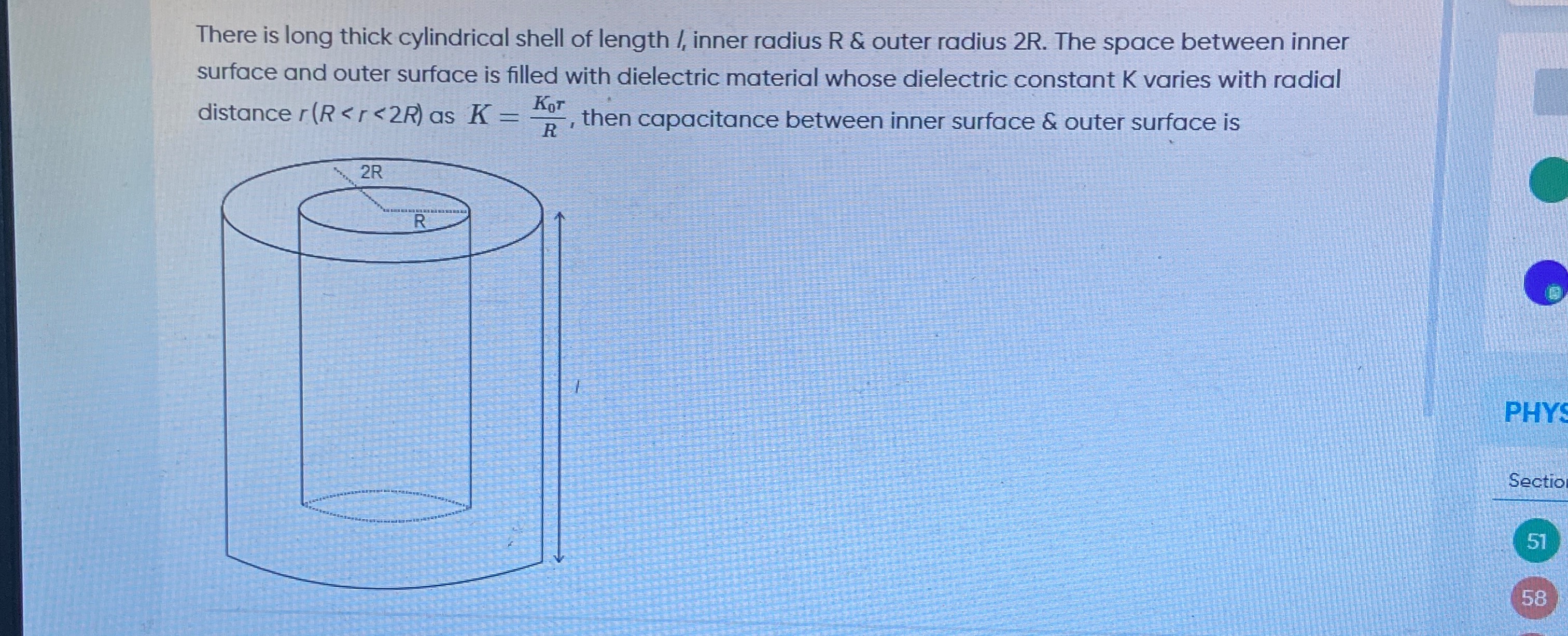Question
Question: There is long thick cylindrical shell of length $l$, inner radius R & outer radius 2R. The space bet...
There is long thick cylindrical shell of length l, inner radius R & outer radius 2R. The space between inner surface and outer surface is filled with dielectric material whose dielectric constant K varies with radial distance r(R<r<2R) as K=RK0r, then capacitance between inner surface & outer surface is

4π ε₀ K₀ l
Solution
The capacitance between the inner and outer surfaces of the cylindrical shell can be calculated using the definition C=VQ, where Q is the charge on the inner surface and V is the potential difference between the inner and outer surfaces.
Assume a charge +Q is on the inner cylinder and −Q is on the outer cylinder. Due to cylindrical symmetry, the electric field E at a radial distance r from the axis is radial. Consider a cylindrical Gaussian surface of radius r and length l (R<r<2R). The electric flux through this surface is ∮E⋅dA=E(2πrl). By Gauss's law in a dielectric medium, E(2πrl)=ϵQ, where ϵ=Kϵ0. Given K=RK0r, the permittivity is ϵ=RK0rϵ0. So, E(2πrl)=RK0rϵ0Q=K0rϵ0QR. The magnitude of the electric field is E=2πϵ0K0r2lQR. The direction of the electric field is radially outwards.
The potential difference V between the inner and outer surfaces is given by V=Vinner−Vouter=−∫R2RE⋅dr. Since E and dr are both radial, E⋅dr=Edr. V=−∫R2REdr=−∫R2R2πϵ0K0r2lQRdr=−2πϵ0K0lQR∫R2Rr−2dr. V=−2πϵ0K0lQR[−1r−1]R2R=−2πϵ0K0lQR[−r1]R2R=−2πϵ0K0lQR(−2R1−(−R1)). V=−2πϵ0K0lQR(R1−2R1)=−2πϵ0K0lQR(2R2−1)=−2πϵ0K0lQR(2R1)=−4πϵ0K0lQ. The potential of the inner surface is higher than the outer surface, so Vinner−Vouter should be positive. The direction of integration is from inner to outer (R to 2R), and the electric field is outwards. So the potential decreases in this direction. Thus, V2R−VR=∫R2REdr=4πϵ0K0lQ. Then Vinner−Vouter=VR−V2R=−(V2R−VR)=−4πϵ0K0lQ. However, the potential difference V in C=Q/V is the magnitude of the potential difference. So, V=∣Vinner−Vouter∣=−4πϵ0K0lQ=4πϵ0K0lQ. The capacitance is C=VQ=4πϵ0K0lQQ=4πϵ0K0l.
